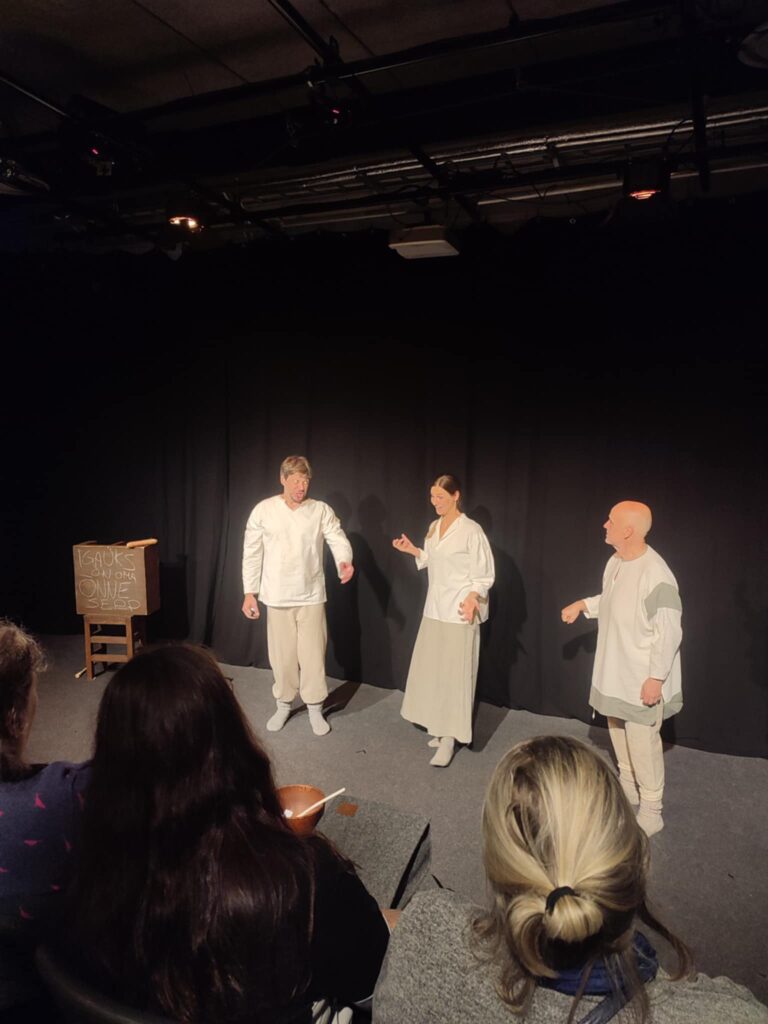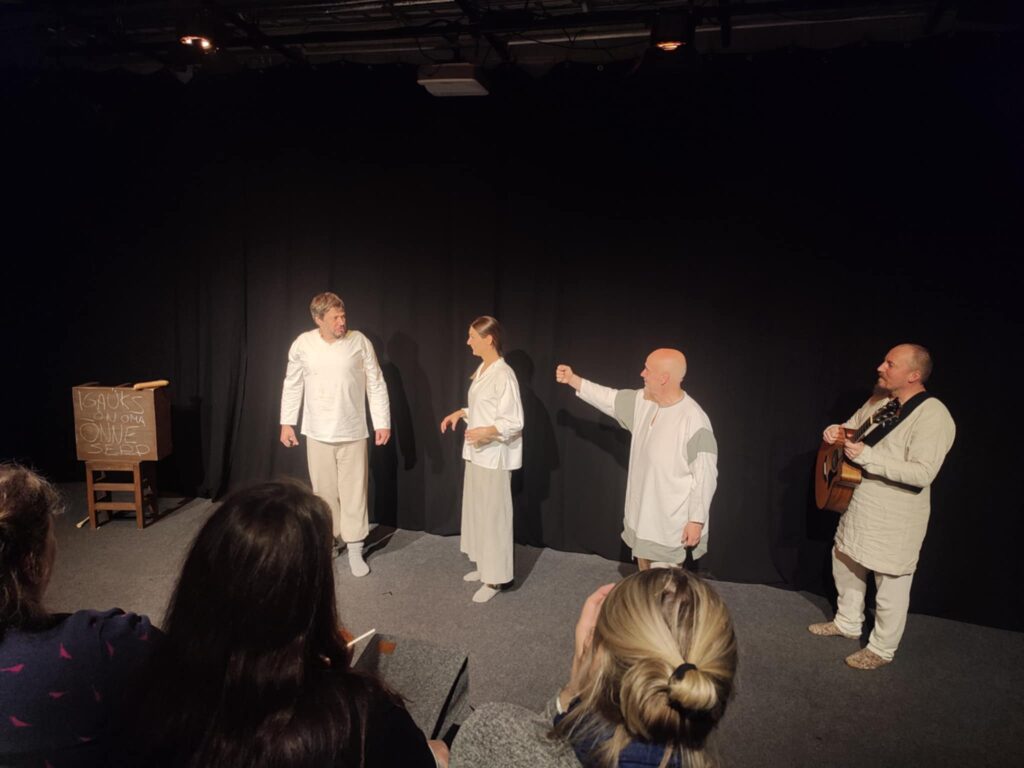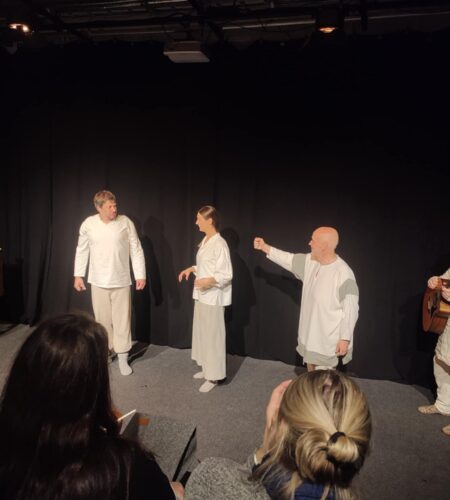“We are peasants.” This is the one unpleasant fact every Estonian knows about their heritage. For centuries, Estonians have been known as quiet, subservient folk with a great passion for the simple things — nature, music, their mother tongue and, most importantly, hard work (done for the benefit of rich and powerful noblemen). The new improv piece “Peasants” (“Matsirahvas“) by Impeerium sets out to reveal these ideas about who we are as a nation.
I have to admit that I immediately loved the premise of doing improv that incorporates Estonian folklore and sayings that most Estonians have heard from their parents, grandparents, or teachers. The only similar premise I have seen in recent times of incorporating several different Estonian folk tales in one play was several years ago in a non-improv production, “Ennemuistsed lood Reinuvader Rebasest” at Eesti Noorsooteater, which had admittedly been a disappointment for me because of the lack of genuine connection with the audience. However, exploring a similar premise based around Estonian folklore, but this time with improv, which in real-time would incorporate sayings and tales directly from the audience, made me a lot more optimistic about “Peasants”.
“Peasants” has a running time of 1 hour and 45 minutes with an intermission, which I found appropriate for this kind of production. The four actors (Tarvo Krall, Maarius Pärn, Ragnar Toompuu, and Mairi Tikerpalu) wore modest traditional clothes: simple white linen shirts and bottoms with woolen socks. During each half, there was a main Estonian folk saying chosen from the audience around which the performance would be based, along with other sayings from the audience and the actors themselves.
The first half, though amusing thanks to the immense talent of the actors, had some issues, particularly with finding a clear and concise storyline to pursue. I believe the problem may have been in the main saying from the audience around which the whole first half was built on — “The more a kid drools, the healthier he is” (Mida tatisem nina, seda tervem laps). The saying seemed to confuse the actors and some of the audience members. The main storyline started to revolve around the characters’ literal snot, which was entertaining to a degree. Still, it became kind of disgusting to watch after a while. Sometimes, the actors would be confused as to which one was supposed to be which character, which led to occasional confusion for the audience. I barely remember the ending because the plot disappeared after the first third.

During the intermission, audience members were instructed to write different folk sayings on slips of paper and put them into a bowl. In the second half, the actors would randomly draw them and include them in the play. The audience loved this; the paper slips to write on were gone within two minutes.
The second half was thoroughly amusing with a more engaging plot because of a better saying: “Igaüks on oma õnne sepp” (“Everyone is the smith of their own happiness”). The saying led to an incredibly engaging plot with twists and turns that kept the audience on their feet. At one point, the whole room was just shaking with laughter. The second part of the story ended in a very Estonian way — the main character Õnne (Mairi Tikerpalu), went out to search for someone who would be the smith of her happiness and came back home just the same as before, with no smith of happiness, but with an interesting story to tell.
One could say there were two mini-plays during the evening. The downside is the heavy reliance on the main saying — it could be a hit or miss; either way, the actors are stuck with it. However, I believe this could be helped by intertwining the two stories with occasional references to create a common universe.
I must commend the improvisational skills of the actors, who managed to consistently entertain the audience and get in several clever jokes. Credit must also be given to the musician (Ragnar Toompuu) and the light technician (Mario Saarik) for their stellar work in creating the atmosphere throughout the play. Particularly impressive were the improvisational skills of the musician on the guitar, who sometimes also had to act out a character at the same time!
I also really appreciated the two consistent bits that the actors would do throughout the play. Firstly, there were several humorous songs, which the actors would improvise and perform using Estonian traditional singing and rhyming methods. The second bit was using an old Estonian word “Kaske!” as a chant, something like “Hear! Hear!” in English. The chant would signal agreement or praise between the characters.

The improv piece “Peasants” was enjoyable. I would even call this evening an Estonian-affirming experience. The way new Estonian folk tales were emerging from the stage made me reflect on the ways that the old ones may have come to existence years ago, perhaps not on stage but maybe at a “rehielamu” (a traditional Estonian farmhouse) with the other peasants after a long hard day of work. Not everything is perfect or refined; it is how it must be in the moment. I must admit I find it hard to recommend “Peasants” to any expats living in Estonia whose Estonian is not, at the very least, at an excellent level. Many of the jokes or storylines incorporated from the crowd or the actors were based on sayings that I would find hard to translate because of the cultural aspects, particularly when the audience or the actors slightly altered any of these sayings for the sake of the joke. Nevertheless, if you still want to experience being a true Estonian for one night, this is the piece for you.
Subscribe to our email newsletter to get the latest posts delivered right to your email.


